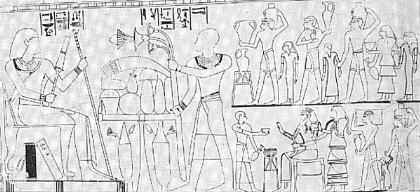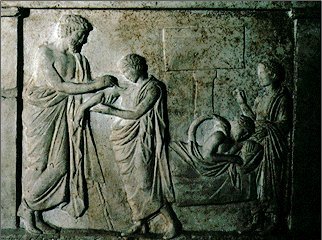



We are not doctors and it is not our intension to practice medicine. We cannot be held responsible for the consequences of self medication. Use this information at your own risk. |
Kami bukan doktor dan tidak berniat untuk membuat rawatan. Kami tidak boleh dipertanggungjawabkan ke atas sebarang kesan atau akibat daripada rawatan sendiri. Sebarang penggunaan maklumat adalah tanggungjawab sendiri. |
It is said that one man's medicine can be another man's poison. The study of medicinal and poisonous plants goes hand in hand and can be traced far back into the ancient times. |
Ancient China 2500 B.C.Chinese traditional medicine is attributed to Emperor Shen-nung (Chin-nung). He is also called the father of China's Medicine and Agriculture. He compiled the first. Pharmacopoeia (Pun Tsao) but it was not actually published till 1600 A.D. by Li Shi Chun. This book mentioned Indian hemp, Aconite, Opium, Poppy and Croton. A number of poisons and antidotes are also given. Ephedria a Gynnospermic plant was used to treat Bronchial asthma. The drug Ephedrine isolated today is used as antihistanune in nasal sprays & decongestants. Asiatic ginsen or Paneax ginsen and American ginsen, Paneax. guinguefolius are used till today as a multi-purpose tonic. Pien Chi'ao [Bian Que] - The most ancient of the physicians from the historical period (ca. 500 B.C.). He was reputed to be an excellent diagnostician, excelling in pulse taking and acupuncture therapy. He is ascribed the authorship of Bian Que Neijing (Internal Classic of Bian Que). |
 A chinese painting of Pien Chi'ao. |
Ancient India 2000 B.C.The Ayurvedic medicine also called the Knowledge of Life is tied in with the Hindu scriptures or the Vedics. For example Rauwolfia serpertine or the Snakes rook was used for curing of 'moon disease' that is, for treating mental illness. It was not used in the USA till early 1950 now the useful reserpine alkaloids is used for mental disorders, hypertension and high blood presure. Ayruveda is based on the teaching of two books, Charaka Samhita and Sushruta Samhita from around 200BC to AD200. Charaka Samhita is mainly a medical text while Sushruta Samhita concentrates on surgery. |
 A tepestry showing Ancient Indian medicine in practice. |
Ancient Egypt 1500 B.C.Egypt had extensive knowledge of medicinal plants with more than 800 prescriptions. Here Allium sativum or garlic had been mentioned in more than 20 of these prescription as an effective agent aganst a variety of disorder, including headaches, worm, heart and urculatery difficulties. Colchicum autumnale or Autumn crocus is used till today for gout. Punica granatum was used as a wormifuge or worm medicine but is not generally used today. Sovereigns from foreign lands have frequently appealed to pharaohs to send them their physicians. A wall painting in a Thebean grave of the 18th dynasty (1400 BC) depicts Nebamun, scribe and physician of the king, receiving a Syrian prince paying him for his services in gifts. According to Herodotus, King Cyrus of Persia has requested Amasis (Ahmose II of the 26th dynasty, 560 BC) to send him the most skilful of all the Egyptian eye-doctors. |
 A wall painting depicts Nebamun in Ancient Egypt.  The Edwin Smith Papyrus is 5 meters long. It described 48 surgical cases of wounds of the head, neck, shoulders, breast and chest. |
Mesopotania (Assyria) 700 B.C. Valley of Tigres and EuphratesHop or Humulus lupulus is used till today to prevent leposy. Hop is also fermented to produce an alcoholic Ale drink. Assyriology now applies to a much wider field: the study of all the civilizations in Mesopotamia and all related questions. Assyriology rests on information from archeological excavations on the one hand and on the study of written documents by philologists on the other hand. Discovery of libraries of clay tablets. The discovery in 1854 CE of the library of A urbanipal (mid 7th century BCE) in Nineveh, halfway the Euphrates river, stirred great interest. This Kuyunjik-collection (called after the discovery site near Nineveh) is at the British Museum. These clay tablets are identified with a K-number. |
 A clay tablet of Ancient Mesopotania. |
|
Greece 450 - 300 BCThis period is called the golden age of the Greek civilization. The father of Greek Medicine is Hippocrates of the Isles of Cos. His oath is still recited by graduates of medical school today. They accepted that diseases as natural and not of supernatual cause. The Greek was well known for the use of Conium moculatun or poison hemlock in executions, for example the execution of the famous phylosopher Socrate. |
 A marble bas relief showing medical practice in Ancient Greece |
Italy (Rome) 1 A.D.During the Roman Empire, there was Caius Plinius Secundus or Pliny the Elder. His work Historia Naturalies consists of 37 books describing more than 1000 plants. Woundwort or Achillea, an atyptic was used to stop bleeding of Roman soldiers in battles and Egypt's Autumn crous was used to apparently prevent cancerous growth. Galen was a Greek doctor, who studied in Egypt and returned to Greece in 157 where he was appointed physician to the gladiators. This was an ideal place to practise medicine, as there were many injuries. In AD 162 Galen went to Rome to become a doctor to the Emperor Marcus Aurelius. |
 Galen dissecting a pig in Ancient Greece |
|
Adapted from Poisonous and Medicinal Plants, by Will Blackwell, 1990, Prentice Hall, New Jersey. |
Kemaskini terakhir (Last update) : 23/09/2004 24/08/02 12/02/02 29/11/01 31/12/00 20/11/00 01/11/00 01/10/00 01/09/00 01/08/00 24/07/00 01/07/00 01/06/00 31/10/99 05/09/99 14/06/99
The colours above gives the year of production, VIEW KEY FOR COLOUR CODES
(Warna-warna di atas menunjukkan tahun bahan diterbitkan, LIHAT PERTUNJUK WARNA).
|
USE "BACK" BUTTON FOR PREVIOUS SCREEN (GUNA BUTANG "BACK" KE SKRIN DAHULU) |
||
 |
GO TO FLORA MALAYSIANA (PERGI KE FLORA MALAYSIANA) |
 |
|
GO TO FAUNA MALAYSIANA (PERGI KE FAUNA MALAYSIANA) |
| |
|
GO TO MUZIK MALAYSIANA (PERGI KE MUZIK MALAYSIANA) |
| |
|
GO TO SUMBER MALAYSIANA (PERGI KE SUMBER MALAYSIANA) |
||
|
GO TO REFERENCES (PERGI KE RUJUKAN) Rujukan On-line |
